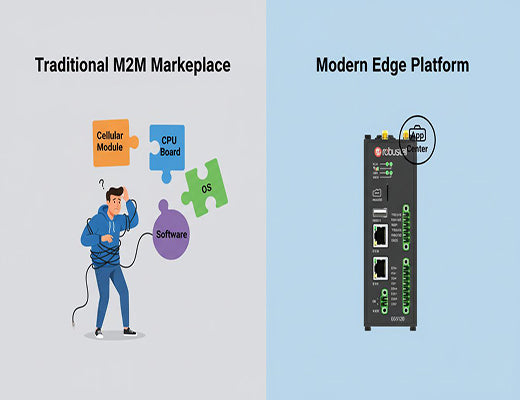
The Evolution of the M2M Marketplace: From Modules to Managed Edge Platforms
|
|
Time to read 5 min
|
|
Time to read 5 min
For years, the m2m marketplace has been the go-to place for sourcing cellular modules, SIMs, and basic terminals to build machine-to-machine solutions. But as the industry evolves from simple M2M connectivity to the complex world of the Industrial Internet of Things (IIoT), the limitations of this traditional model are becoming clear.
This guide explores the evolution beyond the classic m2m marketplace.
We'll discuss why a modern, integrated approach—combining a powerful edge computing gateway like the Robustel EG5120 with a curated App Center—is a more secure, scalable, and cost-effective solution for deploying today's sophisticated industrial applications.
I've spoken with many engineers who have deep experience in the traditional M2M world. Their process was often like building with LEGOs: buy a cellular module from one vendor, a single-board computer from another, source a SIM plan, and then spend months writing custom firmware to glue it all together. The m2m marketplace provided the parts, but you were the one left with the difficult and expensive job of integration.
Let's be clear: that "box of parts" approach doesn't scale for the complex demands of the IIoT. Today, we need more than just connectivity; we need security, remote management, and the ability to deploy complex applications at the edge. The concept of the m2m marketplace hasn't disappeared; it has evolved into something much more powerful: a vertically integrated hardware and software platform. This is a core idea behind any modern Industrial IoT Edge Gateway.

The shift from "Machine-to-Machine" (M2M) to the "Internet of Things" (IoT) is more than just a name change.
This new paradigm requires a new kind of hardware and a new way of thinking about software deployment.
Instead of a fragmented m2m marketplace, the modern approach is to use a powerful edge computing gateway with its own curated software ecosystem. The Robustel EG5120 is a prime example of this evolution.
The EG5120 is built on a powerful NXP i.MX 8M Plus processor and runs a Debian-based OS. This provides a robust and open foundation for running sophisticated applications, a capability far beyond traditional M2M terminals.
This is the modern evolution of the m2m marketplace. Instead of you searching for and integrating disparate software components, the Robustel App Center provides a curated, one-click deployment experience for a wide range of industrial applications.

A fragmented solution from a traditional m2m marketplace creates multiple potential security gaps.
While the upfront cost of an advanced edge gateway may be higher than a simple M2M module, the TCO is almost always lower.

The m2m marketplace was a crucial step in the journey of connecting remote devices. However, the demands of the modern Industrial IoT—for edge intelligence, robust security, and scalable management—require a more sophisticated approach. The future is not in buying a box of parts; it's in adopting a vertically integrated platform. By choosing a powerful edge gateway like the Robustel EG5120 with its own curated App Center and cloud management ecosystem, you are bypassing the integration challenges of the past and building your solutions on a secure, scalable, and future-proof foundation.
A1: M2M (Machine-to-Machine) typically refers to simple, point-to-point communication between a device and a central server. IoT (Internet of Things) is a broader concept, describing a network of interconnected devices that can communicate with each other, process data locally, and integrate with larger cloud services.
A2: Yes, absolutely. The EG5120's Debian-based OS and first-class Docker support provide a completely open environment. You can use the pre-built apps from the App Center for common tasks and deploy your own custom applications in containers for your unique logic.
A3: It's a similar concept but tailored for industrial use. The Robustel App Center is a marketplace of curated, pre-tested industrial software applications that are optimized to run on Robustel's gateway hardware, ensuring reliability and security.